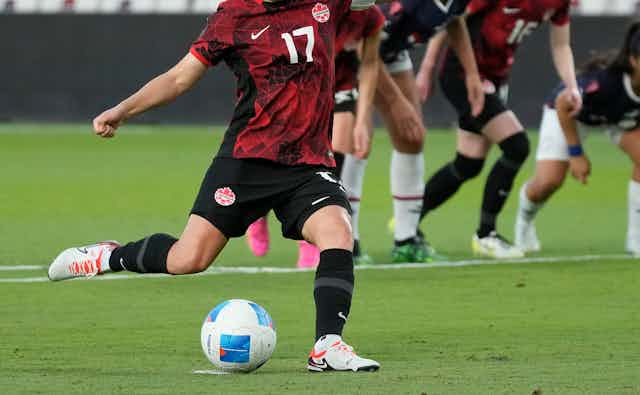Canadian national team athletes have been increasingly calling for accountability from sport leaders over the past few years. The Canadian Soccer Players Association (CSPA), which represents players on the women’s senior team, is the most recent team to take legal action against their organization.
The CSPA filed a $40 million lawsuit in late February against 15 current and former Canada Soccer board members for alleged “negligence and breach of fiduciary duty.”
The lawsuit alleges that a deal Canada Soccer signed in 2018 with a private organization (Canadian Soccer Business) has been impacting the former organization’s ability to operate.
This move follows similar actions by athletes from the national artistic swimming team in 2021 and the water polo team in 2022. These athletes have filed lawsuits alleging varying forms of vicarious liability by their associations.
Canada Soccer accountability issues
In reviewing the events leading up to the CSPA’s lawsuit, most issues point to a failure in board accountability. The roots of the incident can be traced back to March 2018 when Canada Soccer signed a controversial deal with Canadian Soccer Business, which is owned by the Canadian Premier League owners.
The deal involves Canada Soccer giving Canadian Soccer Business sponsorship and broadcast rights in exchange for an annual payment of $3 to $4 million a year. Canadian Soccer Business uses part of the money to fund the men’s Canadian Premier League.
In 2023, a labour dispute began when funding cuts were made to the men’s and women’s national teams. In February of that year, the Standing Committee on Canadian Heritage started looking into the Canada Soccer Business deal and the Canada women’s soccer team went on strike over pay equity issues.
In May 2023, the federal government said it was considering an audit of Canada Soccer. The government had previously commissioned an audit to determine whether public funds were used by Hockey Canada to settle sexual assault cases.
More of Canada’s Soccer financial issues began to come to light throughout the year. In June 2023, interim secretary general Jason deVos announced Canada Soccer was considering filing for bankruptcy protection before signing new bargaining agreements with the men’s and women’s teams.
In February 2024, it was revealed that Canada Soccer had failed to file its financial statements with Corporations Canada as required by the Canada Not-for-profit Corporations Act.
That same month, the CSPA filed a lawsuit against Canada Soccer board members for breaching their fiduciary duty to Canada Soccer when they signed the deal with Canadian Soccer Business.
Board duties and responsibilities
When it comes to improving accountability, Canadian sport organizations and governing bodies have much to learn from national team athletes. These athletes are held accountable to many standards, including:
- academic criteria to maintain their position and scholarships during their junior or varsity careers;
- selection and performance criteria to make a national team;
- qualification criteria at world championships and the Olympics;
- Olympism and ethical standards while competing.
Canada Soccer has the potential to model, both nationally and globally, the same standards of accountability and leadership excellence that are expected of national team athletes.

As political science experts Eric Champagne and Alex Beraskow wrote in 2022, governance is a key lever for positive change in Canadian sport.
The principle that “directors are responsible for supervising the activities of the corporation” is codified in Canadian law. Boards are monitors, not managers, and are responsible to the extent they knew, or ought to have known, of potential problems and failed to remedy them.
Boards have been held vicariously liable in Canada for failing to take preventative measures against foreseeable financial failures or sexual abuse and harassment cases.
Read more: Hockey Canada's issues go beyond a few bad apples — the entire system needs to be re-engineered
Much like coach and athletes, the duty of a board of directors is to adopt an accountability framework — policies and supervision techniques — that demands verifiable evidence of policy implementation and achievement of standards of practice.
Independence, transparency and accountability are necessary to prevent corrupt or negligent behaviours and actions. By looking to sport itself, we can find the governance principles needed to realign our sport system with the Canadian values of hard work, diversity and respect.
Non-hierarchical leadership is needed
Sport works best when following sound governance principles, such as those illustrated in a report on sport governance from the Sport Information Resource Centre, a national sport organization. A new partnership model is needed — one that uses accountability frameworks built on shared values and goals, transparency and independence.
My research with my colleagues on psychologically safe and non-hierarchical leadership models illustrates that coach-athlete partnerships are crucial for achieving optimal performance across all aspects of sport organizations.
Coach-athlete relationships, by nature, are not hierarchical because coaches and athletes are experts with distinct roles and responsibilities who are mutually dependent on one another. These relationships should function as true partnerships that are governed by equity and respect, and are founded on a shared goal of excellence, rather than power or control.
We can scale this coach-athlete partnership model from grassroots to systemic levels and apply it to any governing, officiating, accreditation or funding body.

In a board setting, for example, a coach-athlete relationship could be replaced with any of the following: board-CEO, CEO-staff, CEO-stakeholder or member-board.
The most successful coach-athlete relationships, like the best member-board and board-CEO relationships, are founded upon accountability to agreed-upon standards of practice like that of Sport for Life’s long-term development plan.
Accountability demands independence of roles and responsibilities, transparency of standards and criteria, and evidence of output and achievement. We need only look to sport to see where our sport system is failing; we need only look to sport to see how to fix it.

